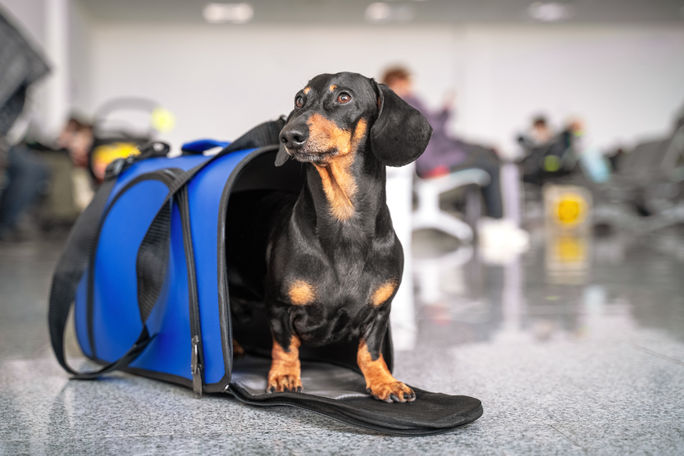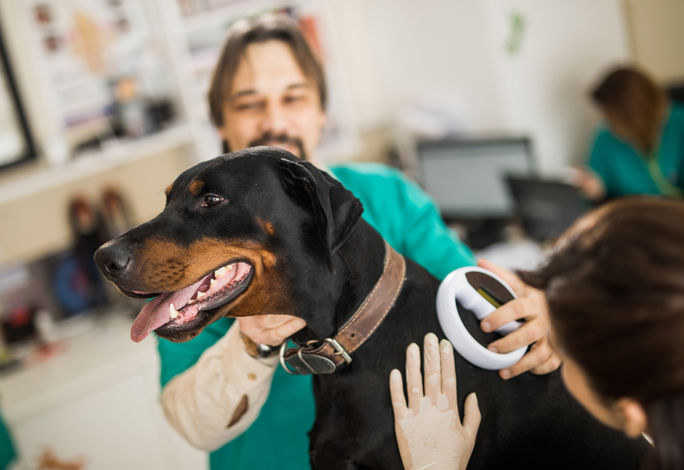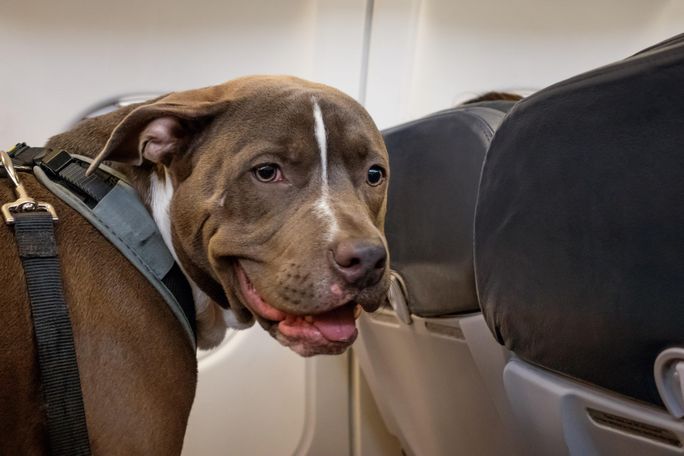As recently as a
decade or so ago, I feel like it was the norm for people to kennel their pets
or, ideally, find a petsitter when they went away on vacation. Nowadays, I see
Instagram reels of adventuresome cats hiking the backcountry with their owners
unabashedly. And, hotels are increasingly adopting a ��pets welcome�� policy, so
no one looks at me funny when I say I want to bring my dogs along on a trip.
While my animal
cohorts and I might stick to the car simply for the sake of ease, plenty of
people are flying with their fur friends, or bringing them aboard trains and
(in rare instances) boats. And, although inviting along your four-legged family
members can greatly enrich your trip, it also involves careful consideration,
thorough preparation and overall great responsibility for each stage of the
journey.
We��ve looked at studies
and questioned pet experts to help illuminate some of the most common and
complex issues that come with the decision to include a pet in your travel
party��whether that��s camping during a domestic road trip or flying across
international borders. After all, your animal companion��s health and happiness
are just as important as the major logistical factors you��ll face during the
trip-planning process.?

PHOTO: A man enjoys New Orleans' Bourbon Street with his pet cat. (photo via Joel Carillet/E+)
Pre-Trip Health Checks
On a very basic
level, you should schedule a visit to your veterinarian before hitting the road
or taking flight, just to ensure that they are healthy and current on their
core vaccines. Depending upon the hazards that are present in your destination,
you may wish to consider other inoculations, such as Leptospirosis, Lyme, Canine
Influenza Virus Rattlesnake vaccines, says Nicole Savageau, a
distinguished veterinarian with the national, in-home service,?The
Vets. You should also
consistently administer any preventive medications, such as those for flea,
tick and heartworm (transmitted by mosquito bite) prevention.?
Be sure to carry
your pets�� documentation, including vaccination records and medical history,
with you during your trip. It��s also wise to research 24-hour emergency animal
hospitals at your destination and have the information at the ready, because
medical emergencies always seem to strike at the most inopportune times and, if
something does happen, it��s difficult to remain clear-headed at that moment.
You can find
listings of Veterinarians & Pet Emergency Hospitals in the United Stateson the American Animal
Hospital Association website. With the rest of your pet��s paperwork, be sure to keep
the National Animal Poison Control��s number (888-426-4435) handy, in
case your pet should ingest something potentially toxic.

A couple camping with their dog. (photo via AleksandarNakic / getty images) (Photo Credit: Getty Images)
Booking Pet Travel
If you��re flying,
you��ll need to make an airline reservation for your four-legged friend when you
make one for yourself, since only a limited number of pets can be transported
per flight. According to Gayle Martz, founder and former CEO and President of the?Sherpa?Pet?Trading Company, and creator of the award-winning
airline-approved "Sherpa" soft-sided pet carrier, you should also do your research
to determine whether there are any special restrictions for pets that are
flying in the passenger cabin.?
Just as important
as contacting your airline or rail provider about their pet-related requirements
and restrictions is reaching out to your intended accommodations��hotel,
vacation rental property or campsite��about their pet policies. While plenty are
billed as pet-friendly, there are varying degrees of pet-friendliness.?
Many will have
breed or weight restrictions, or charge additional fees or deposits for guests
who plan on bringing their animal companions along during their stay. Some
properties go out of their way to make pets welcome, with special amenities,
menus, etc. available that cater specially to furry family members.

Pomeranian mixes @hermieandpoppy ready to order from Chandler's special doggie menu at Cape Rey Carlsbad Beach, a Hilton Resort and Spa. (photo by Laurie Baratti)
Pet Travel Requirements
What requirements
need to be fulfilled for companion animals to travel across state borders or
internationally? Such prerequisites are set by the destinations to which you��re
traveling, but sometimes airlines have their own requirements that must
be met, so be sure to check with your carrier, as well. When it comes to
meeting such conditions, pet parents should realize that preparation (often
well in advance) and proper timing is of the essence.?
Why? Because a Certificate
of Veterinary Inspection (��health certificate��) which must be obtained from and
signed by a federally accredited veterinarian, are only valid for a certain
amount of time. Again, this largely depends upon your destination��s
requirements, but the window is typically within 10 days of border crossing.
You may also need additional documentation from your veterinarian attesting
that your pet is up-to-date on required vaccinations.?
USDA
endorsement of the
certificate can also be a provision for international travel.?For more
in-depth information on this subject, visit the American Veterinary Medical
Association��s (AVMA) resources on?Animal Travel and Transport, and?Basic Timeline for Interstate and
International Travel with Animals.
Note that the
state of Hawaii and many foreign countries also have quarantine requirements for animals,
meaning you��ll be separated from your pet and they will be kept in isolation
for a pre-determined period. This can be an important consideration when it
comes to deciding whether or not to bring a pet along on your trip. For
information about the various pet travel requirements of your destination
country, you should contact
the Consulate or Embassy in that country and learn about their
regulations.

A black-and-tan dachshund dog surveys the airport from the safety of his carrier. (photo via iStock/Getty Images Plus/Irina Mesheryakova)
Proper Identification
It
happens. Animals panic and escape from their carriers or handlers. In
unfamiliar surroundings, they have no way of making their way back to their
owners after they recover from whatever may have spooked them. Making sure that
your pet travels in a secure, airline-approved carrier when flying, or remains
on a leash while they��re out and about is a fundamental part of ensuring their
safety. Even so, they should be wearing up-to-date ID and licensing tags, and
really should be microchipped, as well.
When it comes to microchipping, the steps
aren��t necessarily straightforward, so make sure that you��re getting the right
sort implanted and��this is critical, but frequently overlooked��register the
chip number using your current contact information. Without this step, a
microchip is useless because it doesn��t work as a GPS locator as many owners
seem to believe. The chip itself only transmits a unique number, detectable by
a special scanner, and only once it is entered into a database and registered
to the owner��s information does it become useful. If you��ve adopted a
previously owned pet, contact the microchip company to re-register the chip
with your information. Old and outdated owner contact information is equally
useless.?
It's also
important to pay attention to the type of microchip you��re having implanted.
The usual kind that are used in the U.S. may not help you if your pet get lost
abroad. In fact, some countries will require that pets receive an International Standards Organization (ISO)-certified microchip just to enter their borders. Luckily, these days, many of the biggest pet microchip manufacturing companies are ensuring that their products are ISO-certified, and can therefore be scanned and recognized in other nations.

Veterinarian scanning for dog's microchip at an animal hospital. (Photo Credit: iStock/Getty Images E+/skynesher)
Prioritize Your Pet's Wellbeing
Bringing your fur
baby along on a getaway won��t be much fun for anyone if they are stressed out,
and physically, mentally or emotionally off-kilter. Besides considering their basic
health and safety, you��ll need to plan ahead to ensure their broader wellbeing
by bringing along the things they need to feel safe and comfortable in
unfamiliar surroundings.
First, says Martz,
you can prepare your pet for being in their carrier well ahead of your trip by
getting them comfortable around it. ��At the very least, get the carrier a month
before your trip, and work with your pet on creating a pleasant experience for
them when they are in the carrier. Plan a few easy, short trips with them
traveling in the carrier to places like a dog park so they get excited to go
into the carrier.�� You��ll be surprised to see how, once acclimated, they take
to the enclosed space. Once established as a safe space, dogs tend to view it
as their ��den��, an instinctual throwback that hearkens back to their wolf
ancestors.
This is especially
important if you are traveling by air, Martz points out, ��The best pet onboard
is one that no one knows is there. The pet must remain underneath the seat for
the duration of the flight, so it is important that they are comfortable in
their carrier.��

Be sure to book your pet's air travel at the same time as your own. (Photo Credit: benedek/iStock/Getty Images Plus)
You��ll also want
to bring treats, toys (not the squeaky variety, or you��ll annoy fellow
passengers), a portable water bottle and collapsible water bowl, as well as a
small blanket or item of clothing that smells like you or their home
environment. Dogs�� and cats�� sense of smell is far more dominant in their perceptions
of the world than ours, and this will help your pet feel more at ease.
Martz also advises
that you prepare for potential accidents (potty emergencies or motion sickness)
by bringing extra towels and ensuring that your pet��s carrier has an absorbent liner.
You can line the bottom with disposable potty pads made to absorb urine and
lined with a waterproof plastic film or opt for a washable variety. She also
recommends, ��Avoid feeding your dog a large meal within six hours of traveling
to reduce the chances of motion sickness.��?
A final piece of
advice applies to human-animal interactions is any given situation, whether you��re
at home, strolling the neighborhood or off on vacation. ��It is important to
remain calm,�� Martz says, whatever circumstances you find yourself facing. ��Pets
are sensitive to their owner's emotions. Staying calm and relaxed can help
reduce your pet's stress levels.��?
For the latest travel news, updates and deals, subscribe to the daily TravelPulse newsletter.
Topics From This Article to Explore